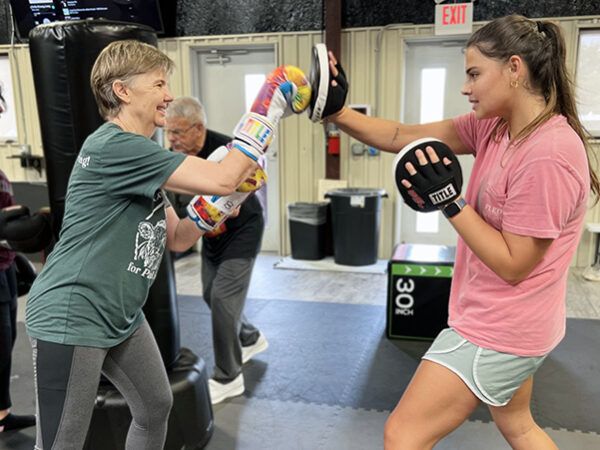Let’s Get Physical: The Science of Fitness
Researchers in the College of Education and Human Development are making the scientific connections between physical exercise and activity, and the interaction between exercise and fitness levels. Their research, application and prevention connects scientists, practitioners and the public to ensure that everyone has opportunities to enjoy a lifetime of better health and wellness.“The first several years of life are a time of immense growth and learning and, for obvious reasons, the home is the primary agent for this development,” says Carl Gabbard, director of the Child Motor Development Lab at Texas A&M. “Although we know the home environment contributes to infant motor development, little research exists examining this relationship.”
Gabbard and his team of researchers developed the Affordances in the Home Environment for Motor Development – Instance Scale (AHEMD-IS). In a nutshell, this instrument assesses the quality and quantity of motor development opportunities available in the home during infancy.
The instrument has been in use in more than 500 homes in the United States, Portugal and Brazil. Findings support the idea that the number and variety of affordances in the home can affect motor development. Infants whose homes had higher AHEMD scores displayed significantly better future motor scores. Research is also currently examining the association between home scores and cognitive ability as the child enters school, notes Gabbard.
“Beginning as early as infancy when a young child’s world is a playground, each toy or piece of equipment affords a new motor action.”
“We anticipate that this project will make a significant contribution toward understanding the potential of the home environment in optimizing motor development of the child — a factor that has come to be recognized as critical to overall infant and child mental health,” says Gabbard.
FIT FOR LIFE
As we progress through various stages of life, fitness requirements change, too. A specific level of fitness may even be required and necessary for career success, and programs like FitLIFE and Curves can make a long-term difference in quality of life.
FITLIFE program researchers in the Applied Exercise Science Laboratory are monitoring the cardiovascular health of more than 200 local firefighters from both Bryan and College Station Fire Departments. The program identifies firefighters who are at an increased risk for developing heart disease to help prevent heart-related fatalities in the field.
“The very nature of firefighting as a profession is one of lengthy periods of sedentary activity separated by intense periods of very strenuous activity,” says Steve Martin, clinical assistant professor of exercise physiology and FITLIFE program coordinator. “Our goal is to determine how fit firefighters are for duty, how at risk they are for developing heart disease and how their susceptibility changes over time.”
By identifying those at risk for heart disease, the researchers hope to prevent the occurrence of cardiovascular events among firefighters. Each participant is provided with a report summarizing the results that includes feedback for major risk factors, as well as lifestyle modification recommendations.
NASCAR pit crews and the Stewart-Haas Racing Team are also benefiting from health research. During his master’s program, David Ferguson investigated the physiological effects of the racing environment on pit crew health and performance. Now a fourth year doctoral student at A&M, he never knew that his love of racing would be tied to his career in exercise science.
Ferguson is the only person to have published a study examining the physiological response of NASCAR pit crews during a race.
“I am a fan and a professional in the field,” David says. “It’s the ultimate feeling of doing what you love.”
David’s study found that simple procedures, such as adjusting training schedules and proper hydration, reduced pit stop times in a sport where hundredths of a second can mean the difference between winning and losing.
The research gathered may be helpful in refining training in major sports such as football, and non-traditional sports, including mixed martial arts. Testing can also have non-sport applications – such as showing how training and exercise can relate to overall health.
FIT SCIENCE FOR WOMEN
Researchers in the Exercise and Sport Nutrition Laboratory (ESNL) have conducted studies examining the short and long-term impact of women participating in the Curves program. Their efforts have affected the lives of millions of women worldwide.
“When women typically try to lose weight, about half or more of what they lose is muscle mass,” says Dr. Richard Kreider, director of ESNL. “That muscle loss can cause a reduction in their resting metabolism, which may make it easier for women to regain weight once they’ve lost it. It’s that yo-yo phenomenon.”
Over the last seven years, Kreider and his research team have completed 15 studies comparing different diet approaches coupled with exercise, including a higher-carbohydrate regimen, a higher-protein plan and an American Heart Association–recommended diet. The team monitors study participants for changes in their resting metabolism, body composition, blood lipids and other indicators.
“Much of what we’re trying to do in these studies is prevent the yo-yo phenomenon by promoting a better weight loss—mostly fat without much muscle mass loss—as well as trying to maintain or even increase resting metabolism, which makes it harder to regain the weight over time,” Kreider noted.
It’s been found that you can effectively promote weight loss without reducing resting energy expenditure through a combination of circuit-type resistance training and maintaining a slightly higher-protein diet.
Diets rich in protein help build muscle, as does resistance training (training with weights). Exercise and increasing muscle mass boosts metabolism, which burns more calories.
Women who have lost weight and want to maintain weight loss should continue to exercise. “If a small amount of weight is gained, reducing their caloric intake for a couple of days every month or so will burn it off before it has a chance to accumulate,” Kreider says.
For media inquiries, contact our Media Relations Coordinator, Ashley Green
Fundraising
To learn more about how you can assist in fundraising, contact Amy Hurley, Director of Development ahurley@txamfoundation.com or 979-847-9455.












